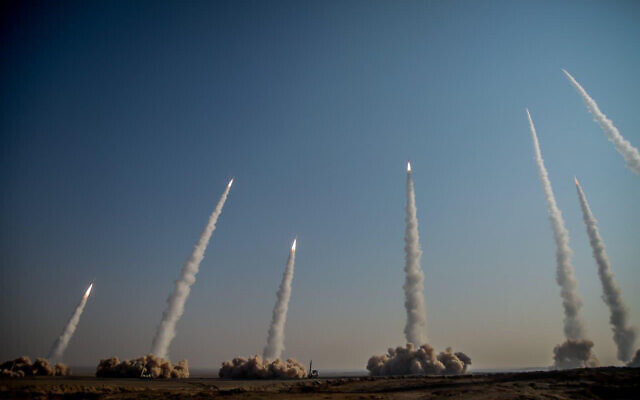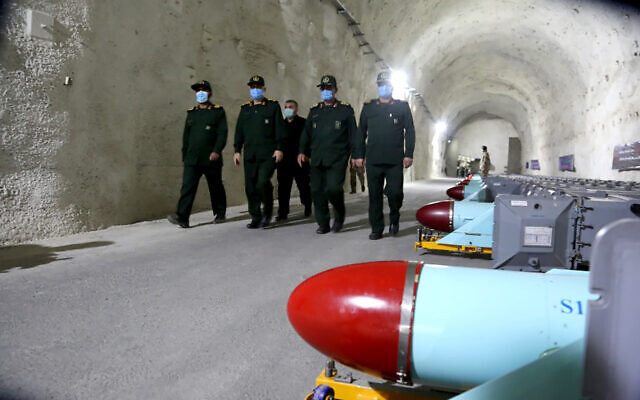In fourth large-scale exercise in recent weeks, IRGC launches ballistic missiles with 700-km range against simulated ‘enemy bases’

Iran’s Islamic Revolutionary Guard Corps forces on Friday held a military exercise involving ballistic missiles and drones in the country’s central desert, state TV reported, amid heightened tensions over Tehran’s nuclear program and a US pressure campaign against the Islamic Republic.
In the first phase of the drill Friday morning, the Guard’s aerospace division launched several surface-to-surface ballistic missiles against simulated enemy bases, state TV reported. It said the drill included Zolfaghar and Dezful solid-fuel ballistic missiles. Bomb-carrying drones were also deployed. The Dezful, a version of the Zolfaghar, has a 700-kilometer (430-mile) range and 450-kilogram (992-pound) warhead.
Iran has missile capability of up to 2,000 kilometers (1,250 miles), far enough to reach archenemy Israel and US military bases in the region. Last January, after the US killed a top Iranian general in Baghdad, Tehran retaliated by firing a barrage of ballistic missiles at two Iraqi bases housing US troops, resulting in brain concussion injuries to dozens of them.
In recent weeks, Iran has increased its military drills. On Wednesday, Iran’s navy held a two-day short-range missile drill in the Gulf of Oman. On Saturday, the Revolutionary Guard held a naval parade in the Persian Gulf. A week earlier, Iran held a massive drone maneuver across half the country.
Additional footage continues to be released. pic.twitter.com/1gUjQSR1WP
— Aurora Intel (@AuroraIntel) January 15, 2021
The IRGC unveiled last week one of its “strategic missile bases” located on the “shores of the Persian Gulf,” according to the corps’ Sepahnews website.
Iranian state television showed underground tunnels and depots of missiles in the south of the country near the strategic Strait of Hormuz.
“Our logic in defending the territorial integrity, the independence of the country, and the achievements of the Islamic Revolution is strengthening,” said the top commander of the IRGC, Gen. Hossein Salami, according to Mehr News. “What you see today is one of several IRGC Naval Strategic Missile facilities.”
The IRGC is designated a terrorist organization by the US.

Tensions have again been rising in the waning days of the administration of US President Donald Trump, as Iran ramps up pressure on the West over the US sanctions campaign against the Islamic Republic.
Iran resumed enriching uranium to 20 percent last week, well in excess of the threshold set out in its landmark 2015 nuclear deal with world powers.
In 2018, Trump withdrew from the deal, known as the Joint Comprehensive Plan of Action, and reinstated US sanctions that had been lifted against Iran, plunging it into recession.
The decision to enrich uranium to 20% — below the 90% required for an atomic bomb, but a relatively short technical step from that benchmark — was not initiated by President Hassan Rouhani’s relatively moderate government, but by parliament, which conservatives have dominated since last year.
After the assassination of top scientist Mohsen Fakhrizadeh on November 27, which Tehran blamed on Israel, deputies approved a bill requiring Iran to resume uranium enrichment to 20% purity, as it had been doing before the JCPOA, and to stock 120 kilograms (265 pounds) of uranium each year.

